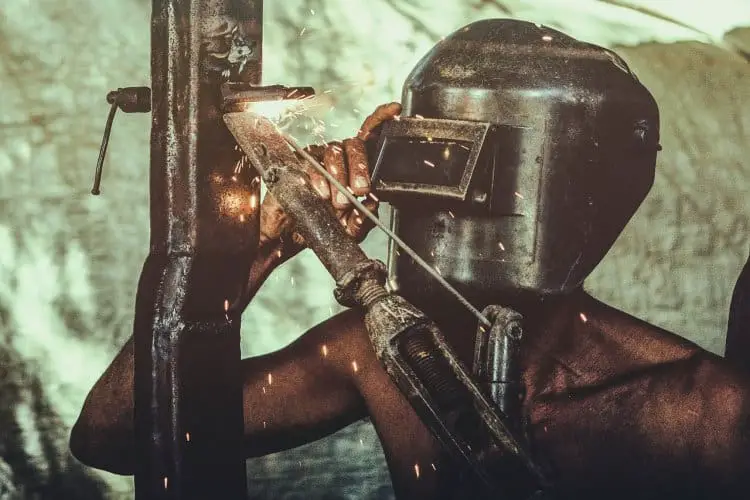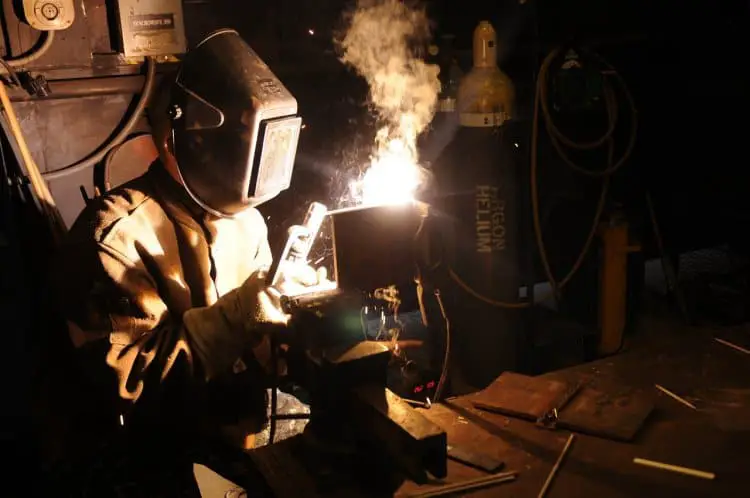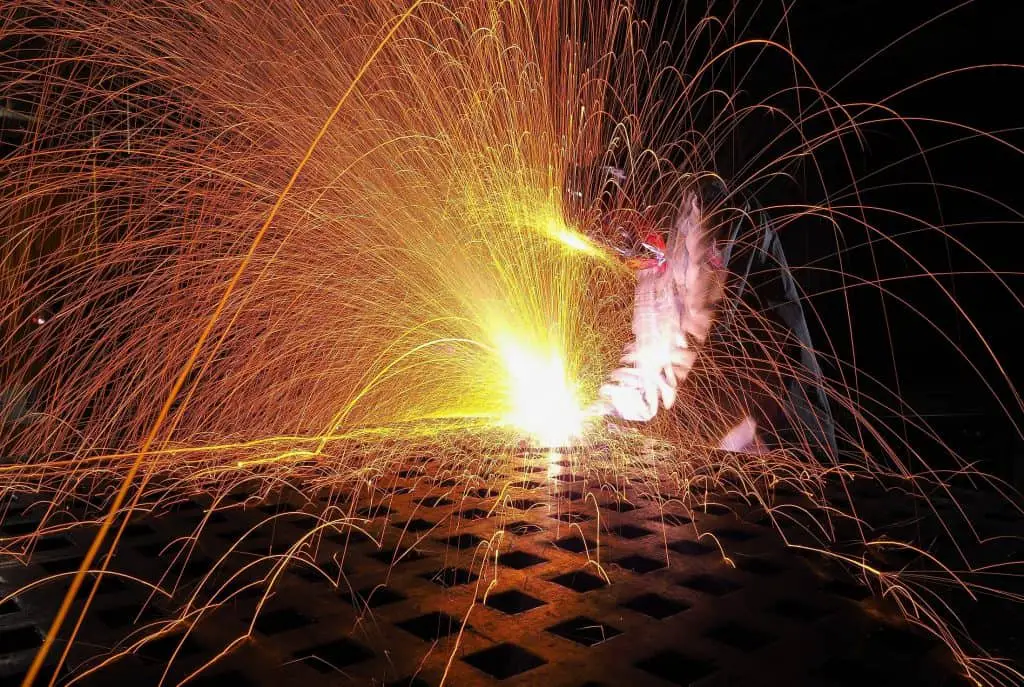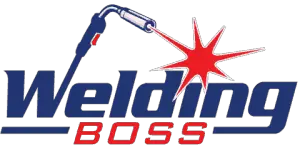This post contains affiliate links to products, services, or education. We may receive a commission for purchases made through links.
Welding helmets protect you from the high heat created during welding. They have a window that is supposed to let you see what you are welding. Some helmets just use tinted, reinforced Plexiglas. Other models use electronic to adjust the tint, but that is only when they work.
So, what can you do when the window of your welding helmet is too dark? If your welding helmet gets too dark, making you blind while welding, you have a few options. Though, your options will vary based on the type of glass used in the helmet and the reason it does not work. Generally, you will only need to press a button, but you also may need to replace the filter, shade, or battery.

Fortunately, you can fix most of the causes. However, you must know the type of tinting you have and the actual cause of the problem.
Why is My Welding Helmet is Too Dark?
Most welding helmets today contain some sort of auto-darkening features. Unless you have an older model or something entry-level, your helmet will adjust the tint of its viewport to ensure you can always see what you are doing.
While these systems work, they can lead to some productivity issues.
In other words, they either do not effectively protect your eyes and head from welding heat and rays, or they work too well and become so dark you cannot see. Either way, you end up blind. While a minor inconvenience, you can fix the issue.
- Often times, you just push the reset button any time your helmet gets too dark. Pressing the button will reset the electronics back to their defaults.
- If the button does not work, then you may have to replace a filter, shade, or battery. The process for this will vary depending on your helmet, and you should check your owner’s manual for more information.
- You may need a professional repair if your helmet gets “stuck” in a dark mode. It is not safe to continue using a broken welding helmet.
Regardless, most people can fix the problem themselves.
Thus, you should always take time to evaluate the real cause of the issue if something goes wrong with your welding helmet.
The solution may be something quick and easy enough to get you back to your project with little disruption.
Sure, you may need a professional repair or a new helmet if something serious is wrong with your helmet if the simple solutions below do not work. However, you want to truly sure you cannot find your helmet before spending the extra cash on a new one.
Fixing Welding Helmet Visibility Problems

There are a number of other problems that you can run into with your welding helmet that will impact visibility.
Problem 1: Poor Visibility
Poor visibility can happen independently of everything else. You can have your helmet set to the most optimal visibility possible, and you may still not be able to see through it on occasion.
In these cases, your helmet may just be dirty. So, you can fix the issue by cleaning it.
Welding helmets collect dust and dirt like anything else. This dirt can accumulate enough to start obscuring your view.
Thus, you can fix the darkness problem just by cleaning the helmet. You should completely clean it often, especially the lens.
If cleaning does not fix the issue, you might need to replace the lens. You should not have to replace the helmet unless the lens is welded into place.
Problem 2: Darkens too Much
You should conduct a sun test every now and then if you use your welding helmet daily. A sun test will tell you if the helmet darkens too fast, which might be a sign of a faulty battery.
Short of replacing the battery, you can fix your helmet by adjusting the light sensitivity.
The sensitivity might just be too high, draining the battery. Lowering the setting may fix the problem and give you more time on the batteries.
Problem 3: Helmet Feels Unreliable
Many welding helmet problems come from an improper fit. If the helmet just does not feel right as you wear it, that might be the case with yours.
While frustrating, especially in the middle of welding, you can easily fix the problem. You just have to tighten up the straps.
Sure, the problem could be something more serious. The helmet can just be broken and unreliable. However, for most people, this is simply not the case.
Usually, the problem is just poor fitting. You just threw the helmet on without thinking if it is the right size for your head.
Fortunately, you can fix every problem you might be having just by properly fitting the helmet to your head before you use it. It might be as simple as tightening the straps and adjustments.
You can test the helmet as often as you need to get the right fit before you start welding.
If it is too tight, try loosening it instead. You should only get a new welding helmet if nothing works.
Problem 4: You Can’t See Enough of Your Weld
If you must turn your head to see what you are welding, the problem may be the size of your lens. While the lens is meant to let you see what you are doing, the lack of visibility can get frustrating.
Luckily, you can fix the problem just by using a wider lens.
Here is a quick tip. You do not need to use the lens that comes with your welding helmet. Many manufacturers produce replacement lenses you can use if the default lens does not work for you.
If a wider lens is available for your model helmet, just use it.
Wide lenses work just like any other welding lens. They are just wider.
They expand your field of view so you never have to turn your head to see what you are welding.
Problem 5: Weld Seems Too Bright

While most people find their helmets too dark, some will have the opposite problem. Especially common with doing more advance, industrial-grade projects, welding helmets can get too bright.
When that happens, you might mistakenly think your helmet has issues, leading you to do something rash.
Fortunately, you can just set the lens to a darker shade. There is nothing wrong with the helmet.
High-end projects tend to skew on the bright side naturally. You just have to readjust the helmet to a more darker shade as needed, remember to revert the settings back when done.
Problem 6: Eye Strain
There is no mechanical fix for eye strain. Once you physically overuse your eyes, you must stop what you are doing and rest.
Thus, you want to ensure you never strain your eyes while wearing your welding helmet.
However, you develop eye strain from not using a dark enough setting. Thus, you have a problem if your help does not turn on the tint quickly enough.
Fortunately, you can fix the problem by decreasing the reaction time.
The reaction time determines how fast the lens darkens. Thus, if it doesn’t tint fast enough, the response time is too long. 1/10,000 second is the recommended reaction speed, but you need to set this according to what works for your body.
Problem 7: Flickers
If the darkness turns on and off, then the problem is with the battery. If you see a flickering side sensor light or the filter stops working, you should replace the batteries.
Replacing the batteries should be simple. You might need to read the manual to figure out how to do it, but most likely your helmet is not damaged. You only need to replace the helmet if you cannot remove the battery.
How do You Test an Auto-darkening Welding Helmet?
If your welding helmet is too dark, most of the time, a simple fix will solve your problem.
You only need to buy a replacement if something series happens, and that largely depends on the quality of your helmet.
Thus, you want to check the quality of your helmet as soon as possible in case something does go wrong. Here are a few common things you can do to test the features of your helmet.
- Different Lenses – different materials require different lens styles. Thus, you want to know what sizes and types of lens are available for your model.
- Note the Type of Power – Auto-darkening welding helmets use different styles of batteries to power themselves. Y
- Know Industry Standards – New models should always meet the latest industry standards.
- Consider Sensitivity – what range of sensitivity settings are present?
- Note Reaction Speed – Large sparks can happen quickly, your helmet must respond fast enough to protect you.
- Weigh it – high-quality welding helmets are light, even with auto-darkening technology, due to their high-quality construction
- Check the Visibility – A welding helmet is useless if you cannot see anything through it
- Use the Sun Test – the sun test tests the overall quality of your helmet by using the sun as a test welding arc. To do the test, but the helmet on and just walk outside and look at the sun.
With these simple steps, you can find the welding helmet with the right about of darkness for your projects.
